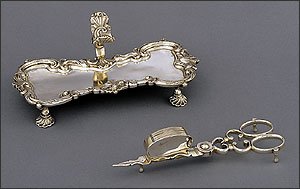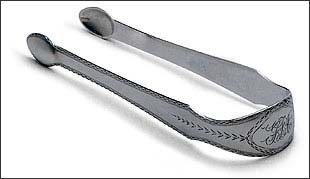Myer Myers: Jewish Silversmith in Colonial New York
 |
The leading silversmith in New York City during the late Colonial period, Myer Myers (1723–1795) produced some of the finest rococo domestic and religious silver in America (Figs. 1, 2). Although Myers’s personal life is documented through the records of his congregation, Shearith Israel, no workshop accounts and few letters or other documents have been discovered that shed light on his career as a silversmith. The 380 objects that survive with his marks provide primary evidence for examining his career.
 | |
| Fig. 1: Candle Snuffers and Tray, Myer Myers (1723–1795), New York, 1750–1765. Silver. Snuffers: H. 1 1/2", L. 6 7/16"; Tray: H. 2 7/16", W. 7 3/8", D. 3 3/4". Courtesy of Yale University Art Gallery, New Haven; Mabel Brady Garvan Collection; photography by Carl Kaufman. |
Myers registered in 1746 as a Freeman, which in New York City conferred the right to vote, hold public office, and engage in retail trade; his registered profession was “goldsmith.”1 No extant records identify the craftsman to whom Myers was apprenticed,but the range of forms and style of Myers’s early work suggests his master was the Huguenot Charles Le Roux (1689–1745). The heir to a large, productive workshop established by his father, Le Roux is known to have trained a number of apprentices.2 Myers’s silver from this early period, which extends into the mid-1750s, includes a teapot (Fig. 3) that exemplifies the simplified late baroque style made popular in London and New York during the 1720s and 1730s by Huguenot silversmiths including Le Roux.
 | |
| Fig. 2: Pair of Torah finials, Myer Myers (1723–1795), New York, 1765–1776 (possibly 1771–1772). Silver and brass with parcel gilding. H. 14 1/4", Diam. base 1 5/16", Diam. center sphere 5 1/4" each. Courtesy of Kahal Kadosh Mikveh Israel, Philadelphia; photography by Will Brown. |
A fortuitous combination of circumstances in the mid-1750s spurred the growth of Myers’s business in the decade that followed. The Seven Years’ War (1756–1763), known in the Colonies as the French and Indian War, economically benefited New York, and by extension its craftsmen, with the sudden influx of money and munitions from Great Britain. The city’s population also grew, surpassing Boston as the second-largest city in America after Philadelphia, providing an increased client base.3 Between 1750 and 1752, Myers married his first wife, Elkaleh Myers-Cohen, the daughter of a wealthy West Indies merchant. And finally, additional financial resources came from the partnership Myers formed, around 1756, with Benjamin Halsted (1734–1817). As Myers was the only Jewish silversmith working in New York during this period he had no traditional kinship base on which to rely, hence this union represents the first formal partnership between two unrelated New York silversmiths.
In the years between 1753 and 1765, Myers’s workshop’s production increased considerably in quantity and quality. His finest work was now in the English rococo style (Fig. 1), featuring sculptural embellishments of shells, foliage, and asymmetrical scrolls. The taste for such rich ornament was more typical of New York than, for example, Boston, where Myers’s contemporaries, including Jacob Hurd (1703–1758), Benjamin Burt (1729–1805), and Paul Revere, Jr. (1735–1818), worked primarily in a more restrained style. Unlike his Boston counterparts, Myers also produced many more exceptional forms derived from English models, such as the candle snuffers and matching tray in Figure 1.
 | |
| Fig. 3: Teapot, Myer Myers (1723–1795), New York, 1746–1754. Silver with wood handle. H. 7 1/2", W. 8 1/2", Diam. base 3 1/8", Diam. rim 2 3/4". Private collection; photography by Richard Goodbody. |
The mid-1760s marked changes in the direction of Myers’s personal life and business affairs. In 1764, he extended his financial reach beyond the silversmith trade when he and two partners invested in a lead mine in northwestern Connecticut. Elkaleh Myers died in August 1765, and in March 1767, Myers married his second wife, Joyce Mears. Halsted and Myers appear to have ended their business partnership in 1766.4
The style and production of Myers’s workshop shifted in the years between 1765 and the Revolutionary War. His business appears to have increased significantly, as over one-third of the surviving objects can be ascribed to this eleven-year span. A survey of these objects indicates an increase in less expensive forms, more likely made for ready retail sales rather than for custom orders. Some of this work, such as the chased sugar dish (Fig. 4), involved skilled labor, but nevertheless seems to have been made in quantities equal to that of the plain alternatives. The increased production of both standard and ornamented wares may have been a response to the succession of boycotts and nonimportation agreements relating to English goods. Such restrictions greatly reduced the quantities of silver imported to the Colonies after 1768, thereby increasing business for local craftsmen.
 | |
| Fig. 4: Sugar dish, Myer Myers (1723–1795), New York, 1765–1776. Silver. H. 5 1/4", Diam. base 2 13/16", Diam. rim 4 5/16". Private collection; photography by Thomas R. Nutt. |
Myers continued to make exceptional labor-intensive objects during this period, and indeed the objects for which he is perhaps best known today—the pierced-work Torah finials (Fig. 2) and dish ring (Fig. 5)—date to this era. These forms are without parallel in the work of other Colonial American silversmiths. While his silver from this period was technically masterful, Myers’s interpretation of the rococo changed from the sculptural ornament of the 1750s to simpler forms with two-dimensional ornament. The emphasis on more delicate effects and abstract patterns was most splendidly realized in the flat-chased and pierced objects produced at this time (Figs. 2, 4, 5).
The British invasion of New York during the summer and fall of 1776 interrupted Myers’s career. Together with many fellow Jews, Myers and his family fled to Connecticut. They first settled in Norwalk, and after the town was burned during a British raid in July 1779, Myers and his family moved farther east on the shoreline to Stratford. In Connecticut, Myers continued to work as a silversmith; extant objects with local histories include a tankard and several spoons.5
 | |
| Fig. 5: Dish ring, Myer Myers (1723–1795), New York, 1770–1776. Silver. H. 4 5/16" (11 cm), Diam. base 8 7/8" (22.5 cm), Diam. rim 7 3/4" (19.7 cm). Courtesy of Yale University Art Gallery, New Haven; Mabel Brady Garvan Collection; photography by Carl Kaufman. |
The British army ended its occupation of New York City on November 23, 1783; Myers and his family returned shortly thereafter. Myers experienced considerable difficulty, however, in reconstructing his career, in part because his workshop had been closed, his network of specialist craftsmen had scattered, and he was 60 years old. Fewer patrons, many of whom suffered from the postwar depression and widespread shortages of money, may have further hampered attempts to rekindle his business.
Based on surviving objects that can be dated by style or provenance to the Federal period, Myers’s output during the last decade of his life never returned to its prewar level. Even with the decreased demand, his workshop seems to have made the shift to the neoclassical style without difficulty, producing forms such as an urn-shaped sugar dish and hooped tankards that represent a stylistic as well as a technical break with his work from the Colonial period.6 Examples of his flatware from this period, such as the sugar tongs in Figure 6, are distinguished by the neoclassical engraving today known as “bright cut,” where deep gouges cut at an angle create patterns that catch light and produce a sparkling effect.
 | |
| Fig. 6: Sugar tongs, Myer Myers (1723–1795), New York, 1784–1795. Silver. L. 5 15/16" (15.1 cm). Courtesy of Yale University Art Gallery, New Haven; gift of Alan R. Kossack; photography by Alex Contreras. |
Myer Myers died in New York in 1795. In his last years, Myers continued to garner the respect of his peers, elected in 1785, for example, as the first chairman of the newly formed Gold and Silver Smith’s Society. One member’s reference to Myers as “that noted and proficient mechanic” indicates the deservedly high opinion in which Myers’s craftsmanship was held throughout his career.7
The exhibition Myer Myers: Jewish Silversmith in Colonial New York was on view at the Yale University Art Gallery from September 14 to December 30, 2001; the Skirball Cultural Center, Los Angeles, from February 20 to May 26, 2002; and the Henry Francis du Pont Winterthur Museum from June 20 to September 13, 2002. This exhibition was supported by a major grant from the National Endowment for the Humanities and generous contributions from other foundations and numerous individual donors.
1. Mayor’s Court Minute Books, vol. for August 24, 1742–February 7, 1749; 377: Division of Old Records, New York County Clerk, New York City.
2. Kathryn C. Buhler, Colonial Silversmiths, Masters & Apprentices (Boston: Museum of Fine Arts, 1956), 23–24.
3. Michael Kammen, Colonial New York: A History (New York: Charles Scribner’s Sons, 1975), 278–79, 330–32; Gary Nash, The Urban Crucible: Social Change, Political Consciousness, and the Origin of the American Revolution (Cambridge, Mass.: Harvard University Press, 1979), 233–46.
4. The New-York Gazette or The Weekly Post-Boy, September 18, 1766, 3.
5. The tankard, made for Daniel Shelton of Stratford, is in the collection of the Toledo Museum of Art, Ohio, inv. 79.122; a teaspoon made for Hannah Finch Benedict of New Canaan is in the collection of the Yale University Art Gallery, inv. 1982.15.
6. The sugar dish is in the collection of the Brooklyn Museum of Art, inv. 52.154; a pair of hooped tankards is in the collection of the Philadelphia Museum of Art, inv. 1922-86-19a,b.
7. David Franks, The New-York Directory (New York: Shepard Kollock, 1786), 69; The New York Paquet and The American Advertiser, January 1, 1784, 4.
David L. Barquist is Associate Curator of American Decorative Arts at the Yale University Art Gallery. He organized the Myer Myers exhibition and is the primary author of its catalogue. Among his other publications is American Tables and Looking Glasses in the Mabel Brady Garvan and Other Collections at Yale University (1992).
This article was originally published in Antiques & Fine Art magazine, fully digitized versions are available at www.afamag.com. AFA is affiliated with Incollect.com.
 |































